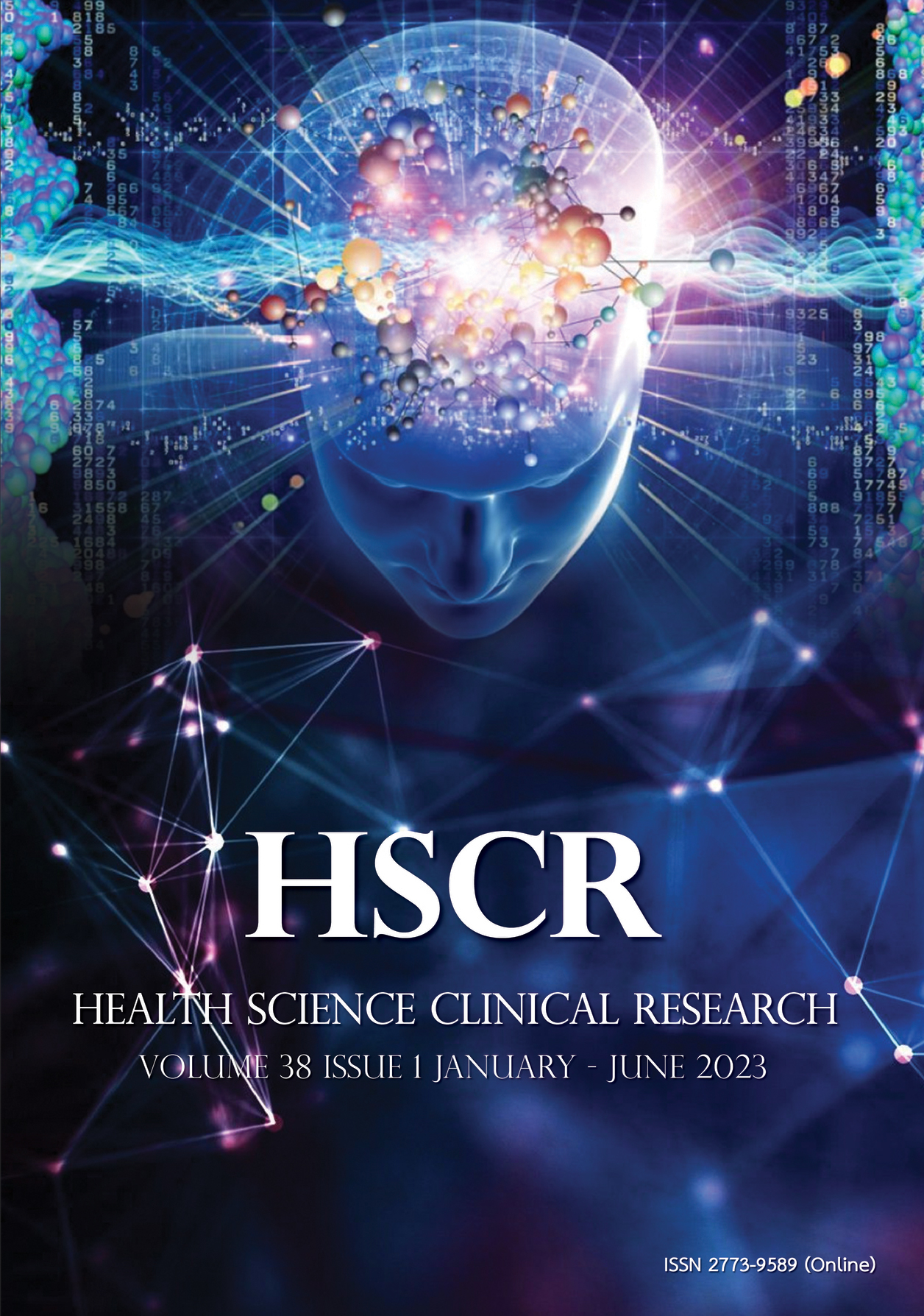Effects of Using Multifaceted Strategic Method on Practices of Registered Nurse in Blood Culture Collection and Blood Culture Contamination Rate
DOI:
https://doi.org/10.1016/hscr.v38i1.261907Abstract
ABSTRACT
Objective : To study the effects of using the multifaceted strategic method on the knowledge and practice of registered nurses in blood culture collection and compare blood culture contamination rate in blood culture before and after using the multifaceted strategic method.
Methods : In this quasi-experimental research, one group pre-test and post-test design study aimed to develop a program to promote strategies in implementing evidence-based practices in management of blood culture collection among nurses. The samples were 44 registered nurses working in the Stroke Unit, Medical intensive care unit, and Respiratory intensive care unit in Uttaradit hospital, and sampling all the blood cultures from the 106 samples. The multifaceted strategic method consisted of the appointment of the lead team, knowledge training, demonstration by video, a reminder poster, performance
feedback, and device support. The research instruments included a blood culture recording form, a questionnaire for the knowledge test, and competencies test in blood culture techniques. The results of the content validity index were .95 and reliability were 0.80 and 0.81 respectively. Analyzed by frequency, percentage, mean, standard deviation, fisher exact probability test, and paired sample t-test.
Results : 1) After using the multifaceted strategic method to promote blood culture collection practice, the registered nurses, average knowledge score was increased from 8.2 to 10.4 and statistical significance at p <0.001. 2) After using the multifaceted strategic method to promote blood culture collection practice, the average competencies score was increased from 34.3 to 35.9, and statistical significance
at .01. 3) After receiving the multifaceted strategic method to promote blood culture collection practice, the contamination rate was lower from 6.2% to 2.8%. Although the blood culture contamination rate is not statistical significance, the risk of blood contamination reduces to 54.7 %
Conclusions: Using multifaceted strategic method had effects on registered nurses’ higher knowledge and practice in blood culture collection and reduced blood culture contamination rates lower than 3.0%
Keywords: Multifaceted Strategic Method, Blood Culture Contamination Rate, Blood Culture Collection
References
Dempsey C, Skoglund E, Muldrew KL, Garey KW. Economic health care costs of blood culturecontamination: A systematic review. Am J Infect Control. 2019;47(8):963-967. doi:10.1016/j.ajic.2018.12.020.
Murni, I. K., Duke, T., Daley, A. J., Kinney, S., & Soenarto, Y. (2018). True Pathogen or Contamination: Validation of Blood Cultures for the Diagnosis of Nosocomial Infections in a Developing Country. Journal of Tropical Pediatrics, 64(5), 389–394. https://doi.org/10.1093/tropej/fmx081
Goto M, Al-Hasan MN. Overall burden of bloodstream infection and nosocomial bloodstream infection in North America and Europe. Clin Microbiol Infect.2013;19(6):501-509. doi:10.1111/1469-0691.12195
Khanna N, Orr D, Qamruddin A. Blood culture collection protocols-do they work. Journal of Infection. 2007;55(3).
งานพยาธิวิทยา, ห้องปฏิบัติการจุลชีววิทยา. รายงานข้อมูลสถิติจำ นวนเลือดที่ส่งตรวจเพาะเชื้อโรงพยาบาลอุตรดิตถ์. [อุตรดิตถ์]: ม.ป.ท.; 2566.
Clinical and Laboratory Standards Institute. Principles and procedures for blood cultures: Approved guideline (CLSI document M47-Ed2).2022;Wayne, PA:
Veronica MP, Chris Z, Keith L, April H. Blood Culture Contamination: Educational Roadmap to Improvement. Am J Infect Control.2019;47(6):s25. Doi:https://doi.org/10.1016/j.ajic.2019.040.44
Rose C. Pearson A, Field J, Jordan Z. Evidence-based clinical practice in nursing and health care: assimilating research, experience and expertise. Oxford: Blackwell, 2007. Evid Based Med [Internet]. 2007;12(5):156–156. Available from: http://dx.doi.org/10.1136/ebm.12.5.156
เยาวมาลย์ เหลืองอร่าม. ผลของการอบรม การให้ข้อมูลย้อนกลับและการสนับสนุนชุดเจาะเลือดต่อความรู้ของพยาบาลและอัตราการปนเปื้อนเชื้อจุลชีพในเลือดที่ส่งตรวจเพาะเชื้อ [Effects of training, feedback, and provistion of blood drawing kit on knowledge of nurse and blood culturescontamination rate] [วิทยานิพนธ์ปริญญามหาบัณฑิต]. เชียงใหม่: มหาวิทยาลัยเชียงใหม่; 2551.
นภสร ดวงสมสา, วิลาวัณย์ พิเชียรเสถียร, พิกุล บุญช่วง. ผลของการพัฒนาคุณภาพโดยทีมพยาบาลต่ออัตราการปนเปื้อนเชื้อจุลชีพในเลือดที่ส่งตรวจเพาะเชื้อ [Effects of Quality Improvement by Nursing Team on Blood Culture Contamination Rate]. พยาบาลสาร. ต.ค.-ธ.ค. 2556;40(4):12-20.
วรรณดี ภู่ภิรมย์, อุราภรณ์ เชยกาญจน์, นิสากร จันทวี. ผลของโปรแกรมการส่งเสริมสมรรถนะแห่งตนต่อความสามารถในการเก็บตัวอย่างเลือดส่งตรวจเพาะเชื้อของพยาบาลวิชาชีพและอัตราการปนเปื้อนเชื้อจุลชีพ [Effects of The Self-Efficacy Enhancement Program on Registered Nurses’ Competencies in Blood Culture Techniques and Reducing Blood Culture Contaminate Rates]. วารสารวิชาการแพทย์เขต 11. ก.ค-ก.ย 2561;32(3):1189-98.
Doern GV, Carroll KC, Diekema DJ, Garey KW, Rupp ME, Weinstein MP, et al. Practical guidance for clinical microbiology laboratories: A comprehensive update on the problem of blood culture contamination and a discussion of methods for addressing the problem. Clin Microbiol Rev [Internet]. 2019;33(1). Available from: http://dx.doi.org/10.1128/CMR.00009-19
Downloads
Published
How to Cite
Issue
Section
License
Copyright (c) 2023 Health Science Clinical Research

This work is licensed under a Creative Commons Attribution-NonCommercial-NoDerivatives 4.0 International License.
The names and email addresses entered in this journal site will be used exclusively for the stated purposes of this journal and will not be made available for any other purpose or to any other party.















